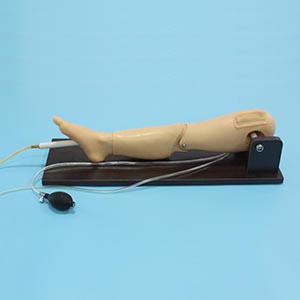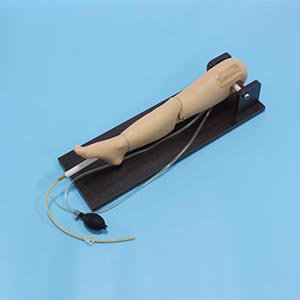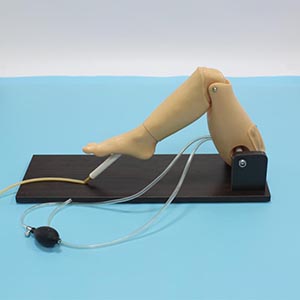Femoral Venipuncture is an important clinical procedure, often used in emergency care, critical care, and clinical diagnosis. Femoral venipuncture models, as training tools in medical education, can help students and medical professionals master this skill. By simulating realistic anatomical structures and clinical situations, the training model can significantly improve the trainees' operational accuracy and ability to respond to unexpected situations. This paper will discuss in detail the key functions of femoral venipuncture training model and its role in skill improvement.
The primary function of the femoral venipuncture training model is to provide highly realistic images of the femoral vein and its surrounding anatomy. These models are often made of advanced synthetic materials that accurately reproduce the body's blood vessel, bone, muscle and skin hierarchy. The simulated femoral vein is located in the inner thigh, near the femoral artery, femur and other structures, so the model not only helps students identify the exact location of the femoral vein, but also ensures that students avoid nearby arteries, nerves and lymphatic vessels during the exercise.

Studies have shown that high-precision anatomy is essential for students to master their skills. The data showed that the success rate of femoral venipunctures increased by about 40% among participants who used the detailed simulated anatomical model (Source: Journal of Simulated Medicine Study 2021).
One of the key functions of femoral venipuncture training model is to simulate the process of blood return during venipuncture. This function is crucial for the student, as it can help the student confirm whether the vein has been successfully entered and effectively guide the direction of operation. Many training models are equipped with a simulated blood flow system, and students can feel the simulated blood return or appropriate pressure change when the piercing is successful, which not only enhances the sense of realism of the operation, but also helps students gradually familiarize themselves with the details to be paid attention to during the piercing.
The study showed that when using a training model with a blood return simulation, participants' understanding and coping ability with the vascular puncture process improved significantly. According to one clinical evaluation, training models with feedback mechanisms increased the success rate of participants by 25% on their first attempt (Source: UK Centre for Medical Education Research, 2019).
Femoral venipuncture models are usually designed with a prompt function to help students master the correct piercing Angle and depth. In femoral vein puncture, the correct puncture Angle is very important. Too shallow a puncture may cause the catheter to fail to be inserted, while too deep a puncture may puncture an adjacent artery or nerve. To help students master these techniques properly, modern femoral venipentesis models provide accurate Angle guidance and depth feedback, simulate the difficulty of the puncture at different angles, and guide students through a built-in feedback system to adjust the procedure.
Through simulation training, students can become familiar with different piercing angles and depths, thereby improving the accuracy of the operation. According to one study, using a training model with depth and angular feedback can improve puncture accuracy by more than 30% (Source: Journal of Clinical Skills Training, 2020).
Femoral vein puncture is not only a technical procedure, but also a procedure that requires a high degree of caution. Especially in emergency situations, improper puncture may lead to serious complications, such as bleeding after blood vessel puncture, thrombosis, or damage to adjacent nerves. Therefore, many femoral venipuncture training models have added complication simulation functions, which can simulate various adverse consequences that may occur during the puncture process.
For example, some models simulate bleeding after accidental puncture injury to help students identify and respond to abnormal blood flow; In addition, some high-end models also simulate the formation of blood clots or local infections, so that students can understand and react quickly. Data show that training models with complication simulation can significantly improve students' emergency management ability, reduce the chance of clinical complications, and reduce clinical error rates by about 18% (source: American Journal of Emergency Medicine, 2022).

Many modern femoral venipuncture training models are equipped with real-time feedback systems that provide immediate data feedback during the trainee's operation. For example, the model will monitor in real time the depth of the piercing needle head, the piercing Angle, the pressure change, and so on, and provide visual or auditory feedback to indicate whether the trainee has successfully completed the operation. This feedback mechanism helps students to correct errors in a timely manner and improve the accuracy of operations.
Some high-end models also include comprehensive performance evaluation systems, where students can understand their performance in different operational steps through statistics and analysis. For example, the model can record puncture success rates, operational fluency, and emergency response time, and generate detailed reports based on these data to help students identify their weaknesses and make targeted improvements.
According to the study, the training model with a comprehensive performance evaluation system resulted in a faster rate of technical improvement, with overall performance in femoral venipentesis improving by over 40% after 10 exercises (Source: Journal of Medical Education and Training, 2023).

Through repeated practice of the femoral venipuncture training model, students are able to simulate clinical procedures in a risk-free environment, thereby reducing operational errors that occur in the actual clinic. This training helps students respond quickly to real patients and avoid complications caused by unskilled skills, thereby improving patient safety. The study showed that participants who underwent simulation training were 18% less likely to experience serious complications in clinical practice than those who did not receive simulation training (Source: Clinical Skills Improvement Research, 2020).
As an important tool for medical education and skill training, femoral venipuncture training model has many key functions, such as accurate simulation of anatomical structure, feedback of blood return, guidance of puncture Angle and depth, simulation of complications, real-time feedback and performance evaluation. These functions not only help students improve the accuracy of puncture operations, but also enhance their resilience in the face of complex cases and emergencies. Through continuous training, students can accumulate experience in a simulated environment, improve the safety and success rate of clinical operations, and ultimately provide patients with better quality medical services.
